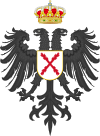
Back كارلية Arabic Карлізм Byelorussian Karlouriezh Breton Carlisme Catalan Karlismus Czech Carliaeth Welsh Carlismus German Καρλισμός Greek Karlismo Esperanto Carlismo Spanish
This article needs additional citations for verification. (June 2023) |
| Part of a series on |
| Carlism |
|---|
 |
| Part of a series on |
| Conservatism in Spain |
|---|
 |

Carlism (Basque: Karlismo; Catalan: Carlisme; Galician: Carlismo; Spanish: Carlismo) is a Traditionalist and Legitimist political movement in Spain aimed at establishing an alternative branch of the Bourbon dynasty,[1] one descended from Don Carlos, Count of Molina (1788–1855), on the Spanish throne.
The movement was founded as a consequence of an early 19th-century dispute over the succession of the Spanish monarchy and widespread dissatisfaction with the Alfonsine line of the House of Bourbon, and subsequently found itself becoming a notable element of Spanish conservatism in its 19th-century struggle against liberalism, which repeatedly broke out into military conflicts known as the Carlist Wars.
It was at its strongest in the 1830s but experienced a revival following Spain's defeat in the Spanish–American War in 1898, when the Spanish Empire lost its last remaining significant overseas territories of the Philippines, Cuba, Guam, and Puerto Rico to the United States.[2]
Carlism continued to play a notable role in the 20th century as part of the Nationalist faction in the Spanish Civil War and the subsequently triumphant Francoist regime until the Spanish transition to democracy in 1975. Carlism continues to survive as a minor party:
Objectively considered, Carlism appears as a political movement. It arose under the protection of a dynastic flag that proclaimed itself "legitimist", and that rose to the death of Ferdinand VII, in the year 1833, with enough echo and popular roots, ... they distinguish in it three cardinal bases that define it:
a) A dynastic flag: that of legitimacy.
b) A historical continuity: that of Las Españas.
c) And a legal-political doctrine: the traditionalist.— ¿Qué es el Carlismo?[3]
- ^ François Velde: The Bourbons
- ^ Mezei, Regina (1996). "Carlism and the Spanish–American War: The Role of the Pretender Carlos VII". Mediterranean Studies. 6: 113–128. JSTOR 41166850.
- ^ Elías de Tejada y Spínola, Francisco; Gambra Ciudad, Rafael; Puy Muñoz, Francisco (1971). "1. El problema del carlismo" (PDF). ¿QUE es el CARLISMO?. Madrid: ESCELICER. p. 10.
Objetivamente considerado, el Carlismo aparece como un movimiento político. Surgió al amparo de una bandera dinástica que se proclamó a sí misma «legitimista», y que se alzó a la muerte de Fernando VII, en el año 1833, con bastante eco y arraigo popular, ... se distinguen en él esas tres bases cardinales que lo definen. a) Una bandera dinástica: Una continuidad histórica: Y una doctrina jurídico-política:
© MMXXIII Rich X Search. We shall prevail. All rights reserved. Rich X Search